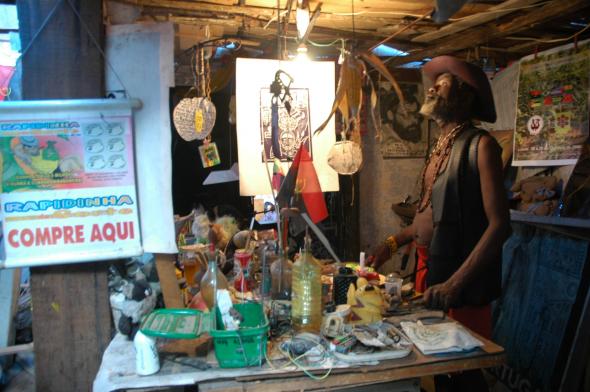Mestre Paulo Kapela – re-membering the disparate
Kapela é pai desses gajos todos.
 Kapela, foto de Kiluanji Kia Henda
Kapela, foto de Kiluanji Kia Henda
Mestre Paulo Kapela takes an exceptional position with his life and work within the artworld of Luanda, Angola’s booming capital. The artist is a fugitive in his own country, a Mukongo from Uige and came to Luanda in 1996. Today he is a kind of artistic and spiritual master for the younger artist generation, even if he barely speaks Portuguese, but French. He became a role model with his unorthodox way of living and his personal universe, but also with his unique way of art-production through a combination of disparate objects and the creation of new contexts. In the last years he has emerged in the context of the Trienal de Luanda, and his artwork has also been shown in the exhibitions Check List - Luanda Pop at Venice Biennial 2007 and Luanda Smooth and Rave in Bordeaux 2009. In 2003 he was awarded with the Art Prize of CICIBA - Centro Internacional de Civilizações Bantú in Brazzaville (Republic of Kongo). In spite of this international recognition, his work can only be understood in his local context, that is to say in his artist studio in the city centre of Luanda.
 Kapela no seu ateliê, foto de Kiluanji Kia Henda
Kapela no seu ateliê, foto de Kiluanji Kia Henda
In this metropolis, we find most of the art-spaces right in the city centre. One example is the rotten building of the National Artist Union (UNAP). It is one of the major places for art-production in Luanda, with two galleries in the first floor and a number of studios in the second, providing space for some of the local artists. The studios of UNAP are not only working place for the artists but also offer a shelter, favoured by the artist’s friends to take a break with a beer or joint at lunchtime and hide away from the crowded and heated streets of Luanda, where the traffic is advancing in millimetre steps.
In one concealed part of the UNAP building one can find a space different from all the others, which bears comparison with Foucault’s heterotopies in its peculiarity, hidden within the noisy and crowded city centre. It is the atelier of Mestre Paulo Kapela, which you can only enter if you know how to call him at the almost invisible entrance. If you enter his studio, it feels like entering another world, almost like a church. Through the decayed roof one can see parts of the sky, accentuating this unique atmosphere. Suddenly one finds himself in a labyrinth consisting out of the countless objects of different origin, like empty cans, toys and plastic flowers. Kapela’s space is filled with surreal arrangements of found things, using every imaginable kind of item to create depictions of his inner universe, combining Bantu philosophy, Catholicism, Rastafarianism and socialist iconographies with a strong sense of a local praise culture. Profane items like advertisements are placed next to religious objects like crucifixes and candles. In between the artworks there are also a lot of paintings in different sizes, fabricated in the style of the Brazzaville Poto-Poto school, where Kapela was working before he came to Luanda. But what really draws attention are the innumerous collages, depicting personalities of his every day life but also politicians and people from the international media. There are works showing Angola’s current president Eduardo Dos Santos next to one of the first president Agostinho Neto and even one of the late leader of UNITA, Jonas Savimbi. Many collages also depict the artist himself with the same characteristics. In many of these collages, Kapela placed a small mirror on the forehead of the depicted person. This might be a reference to the traditional Nkissi sculptures, also known as “Kongo fetishes”, bearing a mirror in their belly, which is said to activate the magical power. In Luanda, one can find those figures in many artist studios, but an adoption into a contemporary artistic position is rare. In Kapela’s recent works there is also a nimbus-like crown of feathers around the head of many portraits. Another common issue of all his works are the writings which frame the collages, mentioning his artist colleagues as well as other elements of Kapela’s personal universe. His own name appears here in different forms, like Paulo Kapela, Mestre Kapela but also as Papa Paulo II Kapela Baafrica Prophete no Congo, merging the figure of John Paul II with the artist himself.
 Kapela no seu ateliê, foto de Kiluanji Kia Henda
Kapela no seu ateliê, foto de Kiluanji Kia Henda
Kapela regards his work as important issue in the context of the reconciliation between European and African cultures as well as for the re-membering of a fractured and amputated society after the years of war. He trying to find a equilibrium between disparate elements, le balance entre le peixe e le maniok, as he mentioned while talking about his philosophy. Thus, his whole artist space can be regarded as an installation, which is able to combine the past and present of his personal life as well as of the country Angola. He is able to recreate this history through his very unique perspective, combining real and surreal narratives and thus recounts Luanda’s nightmares and utopias in his artworks.